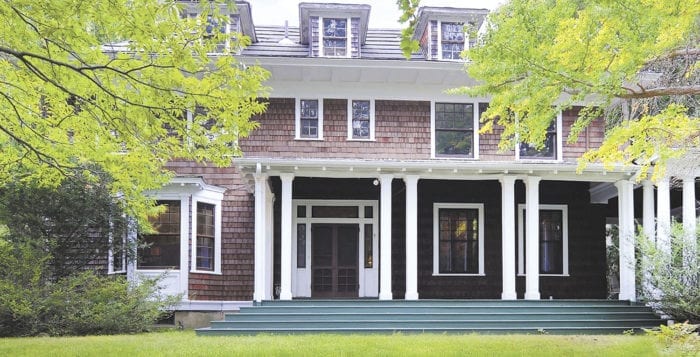A historic estate nestled in Fort Salonga for years has been drawing renewed interest from developers who want to build homes on the property.
The Owl Hill estate, located at 99 Sunken Meadow Road, spans 27.63 acres and is the largest parcel of 1-acre residential-zoned land in Suffolk County. In 2017, the property was up for sale for the first time in more than six decades at the price tag of $6.45 million.
The estate, which is the most expensive property in the hamlet, is owned by Manhattan resident Maya Ryan. Her family has occupied and maintained the house for more than half a century and currently uses it as a summer and weekend residence.
Peter Hans, planning board director for the Town of Smithtown, said in an email the Town currently does not have any type of application for the property but detailed that they have met with several different prospective developers in the past year about how the estate is permitted to be developed.
“The property is zoned R-43 (single-family residential, 1 acre min. lot size),” Hans said in the email. “There are steep slopes on the property which would limit yield on future development. Additionally any developer that would like to subdivide the property would be required to cluster a large portion of the property, meaning that lot sizes would be made smaller than 1 acre so that the difference could be preserved as open space.”
In 2017, the Town and the county raised a $1 million grant to be used to preserve a portion of the Owl Hill property for open space.
Similarly, in an Oct. 2017 TBR News Media article, Owl Hill’s listing agent Kelley Taylor, of Douglas Elliman Real Estate, said she had seen a majority of interest from developers, including one evaluating the property as the site of a 55-and-older community.
Corey Geske, Smithtown resident and scholar, said Owl Hill is a great example of beautiful architecture in the town.
“In my opinion the estate in terms of historical importance is on par with Sagamore Hill,” she said.
Geske said Edmund Wetmore, the first patent lawyer in the U.S., commissioned architect Henry Killam Murphy to design the estate home in 1907. Murphy was renowned overseas for his work in China, Korea and Japan. Some notable work includes designing the campus of the University of Shanghai.
“Owl Hill is one of the finest rare examples of Henry Killam Murphy’s early work in the United States and has been a cornerstone of the community,” she said.
The Smithtown scholar said the estate’s history merits recognition to be established as a national historic landmark, as it’s linked to internationally and nationally known figures.
Residents are concerned about increased development in the area as 2 miles to the west sits Indian Hills Country Club, the site of a potential 55-and-over housing development. The proposed project would call for the construction of 98 town houses, a new fitness center and an expanded clubhouse alongside the existing golf course.
John Hayes, president of the Fort Salonga Property Owners Association, said he is worried about what the potential addition of close to 100 homes at Indian Hills and further loss of green space could do to the character of the area.
“[Indian Hills] would no doubt be the largest development in Fort Salonga history,” he said. “I feel like the rural feel of the hamlet won’t be around for much longer. Who knows what will happen but it would be a terrible shame.”






